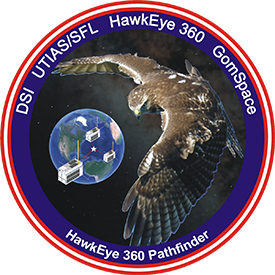HawkEye 360 Pathfinder

The HawkEye 360 Pathfinder mission is a constellation of three small microsatellites being built by Space Flight Laboratory (SFL) based on its 15-kg NEMO platform. Pathfinder is the precursor to a full low-Earth-orbit constellation of small satellites that will commercialize HawkEye 360 Inc.’s space-based radio frequency (RF) detection and geolocation technology.
SFL, under contract to Deep Space Industries Inc. (DSI) for Pathfinder bus development, was selected for this mission due to the importance of tight formation flying by multiple satellites for successful RF signal geolocation and analysis. SFL has developed compact, low-cost formation flying technology at a maturity and cost that no other small satellite developer can credibly offer at present. This precise formation control was demonstrated on-orbit by SFL in the highly successful CanX-4/CanX-5 mission (2014).
Relative position knowledge of each satellite in the constellation is critical to the HawkEye 360 RF system because it relies on triangulation of radio signals from Earth by at least three satellites to accurately geolocate the transmission sources. For the triangulation to be calculated correctly, each satellite must be located with sufficient precision in space and relative to one another.
SFL is incorporating several technologies in Pathfinder that make on-orbit formation flying possible:
- Compact inter-satellite communication link developed by SFL to share data,
- High performance attitude control system also developed by SFL to maintain precise small satellite pointing,
- High efficiency Comet-1 propulsion system developed by DSI.
“By leveraging SFL’s highly successful formation flying technology demonstrated on orbit, along with DSI’s pioneering innovations and next-generation propulsion systems, the mission will deliver unparalleled performance in smaller, affordable satellites,” said SFL Director Dr. Robert E. Zee.
The HawkEye 360 space-based RF sensing technology will enable a variety of commercial applications for government and corporate customers that aren’t possible with terrestrial detection methods. Primary applications will be in the communications, transportation and data analysis markets.
The ability to locate and characterize RF signals across many bands from space, for example, will allow regulators, telecommunications companies and broadcasters to monitor wireless usage to identify areas of interference. In the field of transportation, RF signals transmitted from the air, ground or sea could be monitored. The system might also be used to expedite search and rescue operations by quickly pinpointing activated emergency beacons.

